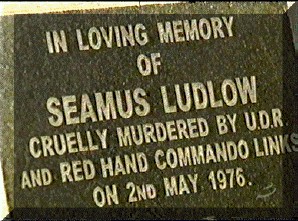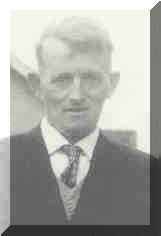Gardaí failed to act after being informed that four named loyalists were
suspected of murdering north Louth man Séamus Ludlow in 1976, a fresh
inquest heard yesterday.
Retired garda John Courtney said officers from the Royal Ulster
Constabulary had given him the names and addresses of the four suspects in
February 1979 during a trip to the North of Ireland.
No one has ever been charged with the murder of Mr Ludlow, who was shot
dead after he left a pub in Dundalk to walk the four miles (6.4
kilometres) to his home.
After passing information on the murder suspects to his superintendent to
be forwarded to Garda headquarters, Mr Courtney said no further
investigation of the men had been taken.
Mr Courtney was a detective inspector at the time of Mr Ludlow’s death
in May 1976. The garda said he had been given the information about the
shooting in Dundalk while on a trip to the North.
“The detective sergeant and detective constable said they might be able
to help me with the murder. They gave me details on how it happened and
the names of the persons involved,” he said.
Mr Courtney said the names of the suspects matched with information being
gathered in Dundalk.
Mr Ludlow was last spotted alive by jockey Cecil Mahon. Mr Ludlow was
walking over the Newry Road bridge on the outskirts of Dundalk as he made
his way home from a pub at around midnight on May 1, 1976.
At 3pm the following day, Mr Ludlow’s fully clothed body was discovered
dumped over a ditch down a lane at Culfore in Mountpleasant, not far from
his home at Thistlecross.
Mr Courtney said he had been given a few details about Mr Ludlow’s
death, including that he was walking along the Newry Road from Dundalk
when he was picked up by the men in a car.
The retired garda said he was annoyed that no directions to question the
men were ever given by the section at Garda headquarters in charge of
subversive-related crime.
Mr Courtney said: “I was anxious to interview these people as they were
strong suspects but I couldn’t do it as I didn’t get the authority to
do it.”
“We would never be satisfied until we interviewed them.
“From descriptions given to me, it would appear they were the people
involved.”
Cross-examining Mr Courtney, the family’s barrister said Mr Ludlow’s
relations had suffered for almost 20 years from rumours that the IRA had
killed him.
Mr Courtney described the Garda investigation as thorough and said: “We
eliminated the IRA from investigations during the early course of
investigation.”
Louth county coroner Ronan Maguire said the inquest was reopening
yesterday 29 years after Mr Ludlow’s death on the directions of Attorney
General Rory Brady.
He said a fresh inquiry had been directed on several counts, including the
fact that no family members were present or informed of the first inquest
in 1976.
After the first day of the new inquest, a nephew of Mr Ludlow, Jimmy
Sharkey, described it as a first step in the family’s fight for justice.
However, he said: “A public inquiry is needed regardless of the outcome
here. It is what the family wants and, after 30 years, it is required.”
John Harbison, the former state pathologist, told the court it was quite
possible that Mr Ludlow had been shot in the back of a car before being
dumped over the ditch.
“His shoes looked remarkably clean in view of the muddy nature of the
lane in which the body was found,” he said.
The inquest heard Mr Ludlow had died from shock and haemorrhaging after
receiving bullet wounds to the heart, right lung and liver.
Professor Harbison, who visited the scene in 1976, said the body had been
discovered lying on top of a bank.
He said it would have taken several people to lift the body.
Due to the amount of black powder residue from the gun on Mr Ludlow’s
hand, Professor Harbison said one of the three shots must have been
discharged from only 15 centimetres away.
On the wound to Mr Ludlow’s left hand, Professor Harbison said: “It
was almost certainly sustained by the deceased trying to shield the bullet
with his left hand.”
The professor said two bullets found in the blood-stained clothing of Mr
Ludlow — as well as the bullet lodged in his body — had been given to
the Garda ballistic section for examination.
Dr Maguire adjourned the inquest to hear further evidence from four other
witnesses.

Daily Ireland, 6 September 2005:
Murder of quiet man
by Andrea McKernon
Seamus Ludlow was a quiet, unassuming bachelor who lived in Co Louth
with his elderly and infirm mother, his sister and her children.
He was gunned down on May 2, 1976 near his home in Thistle Cross,
Mountpleasant close to the Border by loyalists in collusion with the UDR.
This week, almost 30 years after his murder, a new inquest opened
yesterday into his death after relatives said they were not informed of
the original hearing in 1976. But they are still campaigning for a full
public inquiry.
From his post mortem in 1976 state pathologist John Harbison revealed that
the Fine Gael member had a number of bullet wounds to his heart, lungs and
liver and the shot that killed him had passed through his left hand, which
he had raised to protect himself from his killers.
Why anyone would want to murder the 47-year-old forestry worker whose only
recreation was to have a drink in his local bar every week was a mystery
to over 2,000 mourners who attended his funeral.
Gardaí questioned 2,000 people, searched almost 2,000 homes and stopped
over 1,000 vehicles, but after four weeks the investigation into Mr
Ludlow’s murder abruptly stopped. It later emerged the RUC was
protecting an informer working for the British security forces.
His devastated family was told unofficially that their loved one had been
killed by the IRA as an informer, but the allegations were untrue and the
family became divided over the following 20 years.
Family members had even been told by the gardaí that other family members
linked to republicans had been involved in their relative’s murder.
However in the mid-1990s Northern journalist John Ellis told the family
that he had information the murder was carried out by loyalists and not
republicans, confirmed by a retired senior detective who had worked on the
case.
The revelations led to Mr Ludlow’s nephews, Michael Donegan and Jimmy
Sharkey, launching a campaign into their uncle’s murder.
That led to the reopening of the investigation on both sides of the
Border. Four suspects were arrested – three from North Down and another
who had originally lived in the area. But the four suspects were later
released by the RUC. However a file was prepared for the Director of
Public Prosecutions in Belfast.
In July 1999, former Tánaiste John Wilson produced his report on behalf
of the Victims’ Commission recommending a private inquiry into the case.
“To avoid compromising any criminal prosecution, this inquiry should not
publish its report until any prosecution has finished, unless no
prosecution has been initiated before the completion of the inquiry or
within 12 months, whichever is the later.”
Despite protests by family members on the limitations of such a probe,
their hands were tied while the four men’s case remained on the DPP’s
files in Belfast.
But on October 20, 1999 the DPP announced there would be no prosecutions,
removing the logic behind the Irish government’s private inquiry whose
report would not come into the public domain. That started a six year-long
campaign for a public inquiry.
At present the Ludlow family’s campaign is waiting on two important
developments in Dublin: the publication of a private Barron Inquiry report
and the opening of a fresh inquest. The Barron Report, completed after a
private inquiry into the murder by Mr Justice Henry Barron, was passed to
the Irish government in October 2004. No date for its publication is
available. The fresh inquest, delayed since it was ordered by the Irish
attorney general in July 2002, opened yesterday.
|


